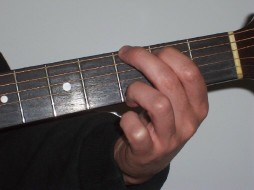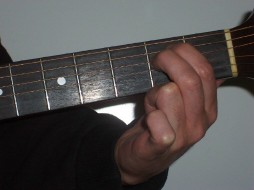 |
| Lesson 5 | |||||||||||||||||||||||
|
In this lesson we will look at 2 new scales and how to find a major keys relative minor. At the end of the lesson you can use your new scales to play over a jam track. Plus we will learn our open Em and G chord and a new strum pattern using quarter notes and eighths notes.
|
| ||||||||||||||||||||||
| | |||||||||||||||||||||||
| Scales - G Major | |||||||||||||||||||||||
| Let's
build a G major scale. We will use the major scale formula we learned from lesson
2 W W H W W W H |  | ||||||||||||||||||||||
| 1.
Start on open G and go up a Whole step to A (2nd fret) | |||||||||||||||||||||||
 | |||||||||||||||||||||||
| So the
G major scale has one sharp (F#). This also means the key of G major has one sharp
(F#). F#'s enharmonic equivalent would be Gb however in the key of G we will call it F# . Every major scale must use every alphabet letter. If we called it Gb we would have skipped the letter F. | |||||||||||||||||||||||
| For some suggested fingerings and a video of the G major scale on the G string Click Here 1st Position G major scale one octave (also known as open G major scale) | |||||||||||||||||||||||
| 1st finger looks after 1st fret |
 | ||||||||||||||||||||||
|
You may want to down pick every note until you get the notes under your fingers than try and alternate pick the scale. Be sure and try to say the notes as you play the scale. You want to be able to play the scale but you also want to know those notes. | |||||||||||||||||||||||
| 1st Position G major scale 2 octaves We can also build the G major scale starting on a low G. This will allow us to play the scale 2 octaves. | |||||||||||||||||||||||
 | |||||||||||||||||||||||
|
With this scale you will use your 4th finger to play the F#. Like the one octave scale, once you feel you have the scale under your finger tips, you should try alternate picking the scales. Again, don't forget to say the note names. Midi File - G major scale for slower internet connections (right click to open in new window) | |||||||||||||||||||||||
| | |||||||||||||||||||||||
| Theory - Relative Keys Every major key and major scale has
something called a relative minor. We find the relative minor by going down 3
half steps or by starting on the 6th degree of the major scale. | |||||||||||||||||||||||
| | |||||||||||||||||||||||
| 1st Position E minor scale 2 octaves | |||||||||||||||||||||||
 | |||||||||||||||||||||||
 | |||||||||||||||||||||||
| Notice the E minor scale shares all of the same notes from the G scales. You just have to start on an E. So we will start with our low open E and move a whole step to F# on your 2nd fret. After that everything should look like the G major scale from above.
| |||||||||||||||||||||||
| | |||||||||||||||||||||||
Diatonic Triads in G In lesson 3 we built all of the triads belonging to the key of C. We will follow the same rules of space, space, space, line, line, line to build the chords belonging to the key of G.
These are also the chords belonging to E minor. E minor would become the i chord, F# diminished would become the iidim chord, G major would be the III chord and so on. So in regards to relative major and minor keys, they share the same notes, same chords and the same key signature. We will get into this more and more with each lesson.
| |||||||||||||||||||||||
| Chords - Open G
| |||||||||||||||||||||||
 |  | ||||||||||||||||||||||
| Note
if you wanted to use your open G and B strings to play the above triad, you wouldn't
have anywhere to play the D. However, you could play this triad in 3rd position
(strings 2 3 4) or 7th position (strings 3 4 5) or 12th position (strings 4 5
6). More on that later. | |||||||||||||||||||||||
| A more common way to play the G chord is to play more than one of each chord tone. | |||||||||||||||||||||||
 |  | ||||||||||||||||||||||
 |  | ||||||||||||||||||||||
| | |||||||||||||||||||||||
| E Minor There are two ways to build an Eminor chord. We can either take the 1st, 3rd and 5th degree from the E minor scale and play them together or we can go to the 6th degree of the G major scale and stack the notes. Either way we end up with the same 3 notes. E , G and B | |||||||||||||||||||||||
 |  | ||||||||||||||||||||||
| Once again we will play more than one of each chord tone to allow us to play more than just 3 strings. In this case we can strum all 6 strings. |  | ||||||||||||||||||||||
 | |||||||||||||||||||||||
| | |||||||||||||||||||||||
| Strumming Keep your 1st (index) finger down when making the switch from G to Em. Then from Em to C you want to try and keep your 2nd (middle) finger down through the switch. Lastly, from C to Am you want to keep both your 1st and 2nd finger down and only move your 3rd (ring) finger. Review C to Am switch. To expand on our strumming we will play quarter, two eighths, quarter, two eighths for each measure. You can think about is as long, short short, long, short short and strum down, down up, down, down up. | |||||||||||||||||||||||
 | |||||||||||||||||||||||
| You may want to start practicing the C to G switch as it is a tough one and will be used in an upcoming lesson. | |||||||||||||||||||||||
| | |||||||||||||||||||||||
| Improvising Lets
try improvising over the chord progression above. If we analyze the progression
we could solo in either the key of G or the key of C. Because it starts on a G
chord, most would probably solo in the key of G.
| |||||||||||||||||||||||
| |||||||||||||||||||||||
| Try playing your C scale from lesson 2 or 4 and try your G scale from above. | |||||||||||||||||||||||
| | |||||||||||||||||||||||
| Daily
Practice Routine
| |||||||||||||||||||||||
| Vancouver British Columbia Canada 604 357-3551 http://www.musiclearning.com |


